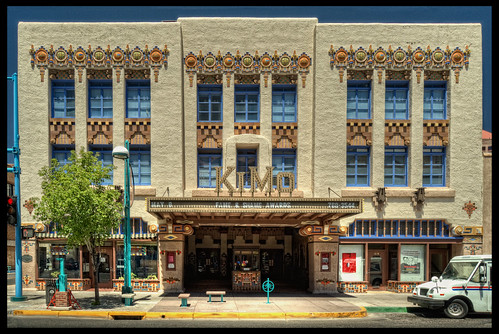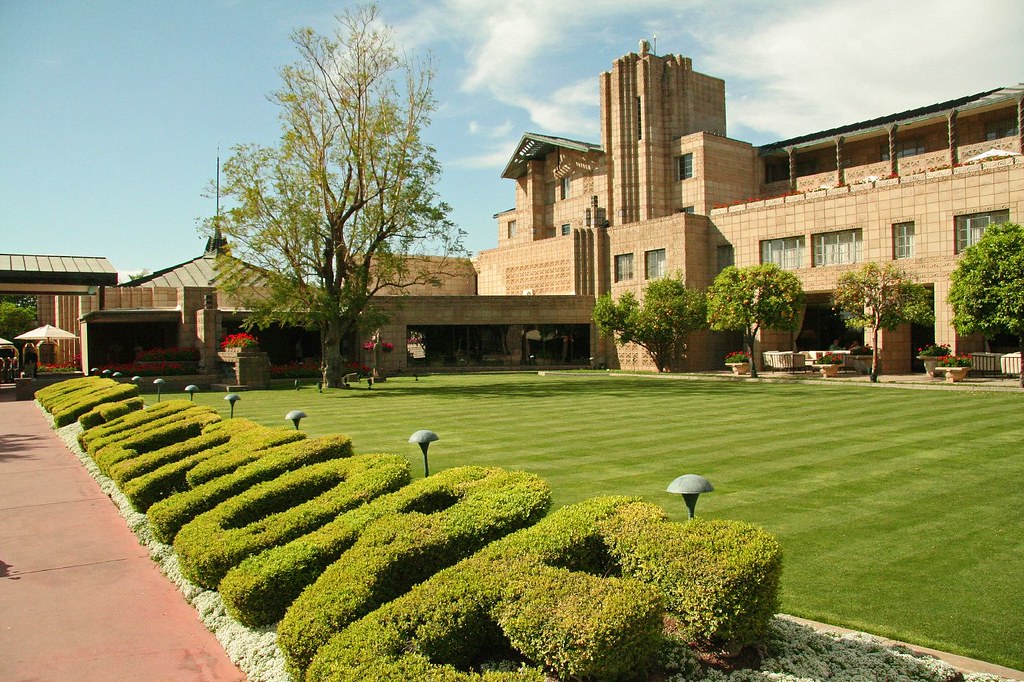I learned about an uncommon, unusual design style known as Pueblo Deco as I researched Pre-Nazi Swastika Architectural Details. Native American tribes of the US Southwest such as the Navajo used a symbol that that the general public today would call a swastika. That element carried forward to some of the derivative Pueblo Deco buildings constructed prior to the Second World War, which is how I came across the style.
Pueblo Deco arrived at the intersection of two other architectural movements popular during the early part of the 20th Century through the 1930’s, Art Deco and Pueblo Revival. 12MC isn’t an architecture site and I don’t have any training in the field. So I won’t even begin to describe the styles. However, I’ll let the images explain themselves: Art Deco became an unmistakable you know it when you see it design and Pueblo Revival seemed rather self-explanatory too. Imagine a mash-up of the two. Their spawn became Pueblo Deco.
KiMo Theatre, Albuquerque, New Mexico

Albuquerque’s KiMo Theatre may best exemplify Pueblo Deco, or at least serve as its most recognizable landmark (map). I featured this property in my earlier article and it sparked my initial curiosity.
The City of Albuquerque purchased the KiMo Theater in 1977, saving it from probable destruction after years of neglect. It began as the vision an immigrant entrepreneur, Oreste Bachechi, and opened in 1927 during the golden era of elegant movie palaces. As the city’s Kimo Theater History explained, Bachechi wanted a building “that would stand out among the Greek temples and Chinese pavilions of contemporary movie mania.” His architect Carl Boller “traveled throughout New Mexico, visiting the pueblos of Acoma and Isleta, and the Navajo Nation” in search of inspiration. Even the name KiMo derived from the pueblos; it reflected a Tiwa word for mountain lion.
Albuquerque seemed to be the epicenter of Pueblo Deco. The Art Deco Society of New Mexico even published a Pueblo Deco Tour of the city.
Arizona Biltmore Hotel, Phoenix, Arizona

Then Pueblo Deco spread within neighboring Arizona. The state’s preeminent example may be the Arizona Biltmore Hotel in Phoenix. It later became an Waldorf Astoria resort, billed as “The Jewel of the Desert since 1929” (map).
Sometimes observers mistake it for a Frank Lloyd Wright structure. While Wright consulted on the project for several months, his former student Albert Chase McArthur designed it. As the hotel’s history page noted,
“Perhaps the most obvious and dramatic design link to Wright is the use of indigenous materials that led to the creation of the ‘Biltmore Block.’ The pre-cast concrete blocks were molded on-site and used in the total construction of the resort.”
The Arizona Biltmore anchored a high-end commercial and residential neighborhood that developed around it, the Biltmore District. Famous celebrities and politicians relaxed in the desert over the years. For example “Irving Berlin penned many tunes, including ‘White Christmas’ while sitting poolside at the Arizona Biltmore.” The hotel last scored a minor historical footnote as the site where John McCain conceded defeat after his failed 2008 presidential campaign.
(former) Casa Grande Train Station, Casa Grande, Arizona

However, Pueblo Deco buildings didn’t need to be grandiose and monumental to fit the general style. They could be rather utilitarian. For example, the Southern Pacific Railroad constructed a station in Casa Grande, Arizona in 1940. It presented a rather simple design although it clearly displayed elements of the fusion. Unfortunately despite its listing on National Register of Historic Places, the building fell into neglect. Then it remained empty for many years, caught fire in 2009 and preservationists could not save it. The Casa Grande Firefighters site included photographs of the fire that resulted in this horrible loss.
The station used to stand at 201 W Main Street, now a vacant lot. Such a pity. Google Street View recorded images before and after the fire.
Cliff Dwellers’ Apartments, New York City, New York

While primarily a regional style generally confined to the desert southwest, Pueblo Deco sometimes appeared outside of its natural range. For example, the Cliff Dwellers’ (Cliff Dwelling) Apartments on Riverside Drive between West 96th and 97th Streets in New York City employed a number of similar design characteristics (map). The New York Times featured this structure in 2002, describing it as “A Terra Cotta Masterpiece.”
“On the exterior, [Herman Lee] Meader again used terra cotta inventively. His designs of double-headed snakes, the skulls of cows, mountain lions, scowling masklike faces, spears and various American Indian details were worked into ornament. In 1916, The New York Herald praised the Cliff Dwelling’s appearance on a lot that had been considered ‘only fit for a billboard’ and hailed its ‘made-in-America feeling.’ The Herald said its name opened up a new horizon for developers who had ‘exhausted the supply of names and styles from every famous palace, chateau and castle in Europe’.”
It created an interesting solution for a narrow, oddly-shaped lot. All apartments faced towards the Riverside Drive side of the building. CityRealty called it “…New York City’s architectural ode to the Wild West, this narrow and angled building is one of the city’s most eccentric” and noted that the American Institute of Architects had earlier said, it “symbolizes the life of the Arizona cliff dwellers and serves to tie these prehistoric people to Manhattan’s modern cliff dwellers.”
It All Gets Confusing
I found plenty of other buildings described as Pueblo Deco, or not. Once again my lack of architectural background made it impossible for me to parse. Did the La Fonda Hotel in Santa Fe qualify as a Pueblo Deco structure, or Pueblo Revival? Should I call Fort Worth’s Texas & Pacific Railroad Passenger Station Pueblo Deco or Zigzag Moderne Deco? I dunno. Sources differed and I didn’t have the knowledge to make an intelligent judgment. I still enjoyed looking at them.
I didn’t even know Zigzag Moderne existed. Maybe I should stick to geography.

Leave a Reply